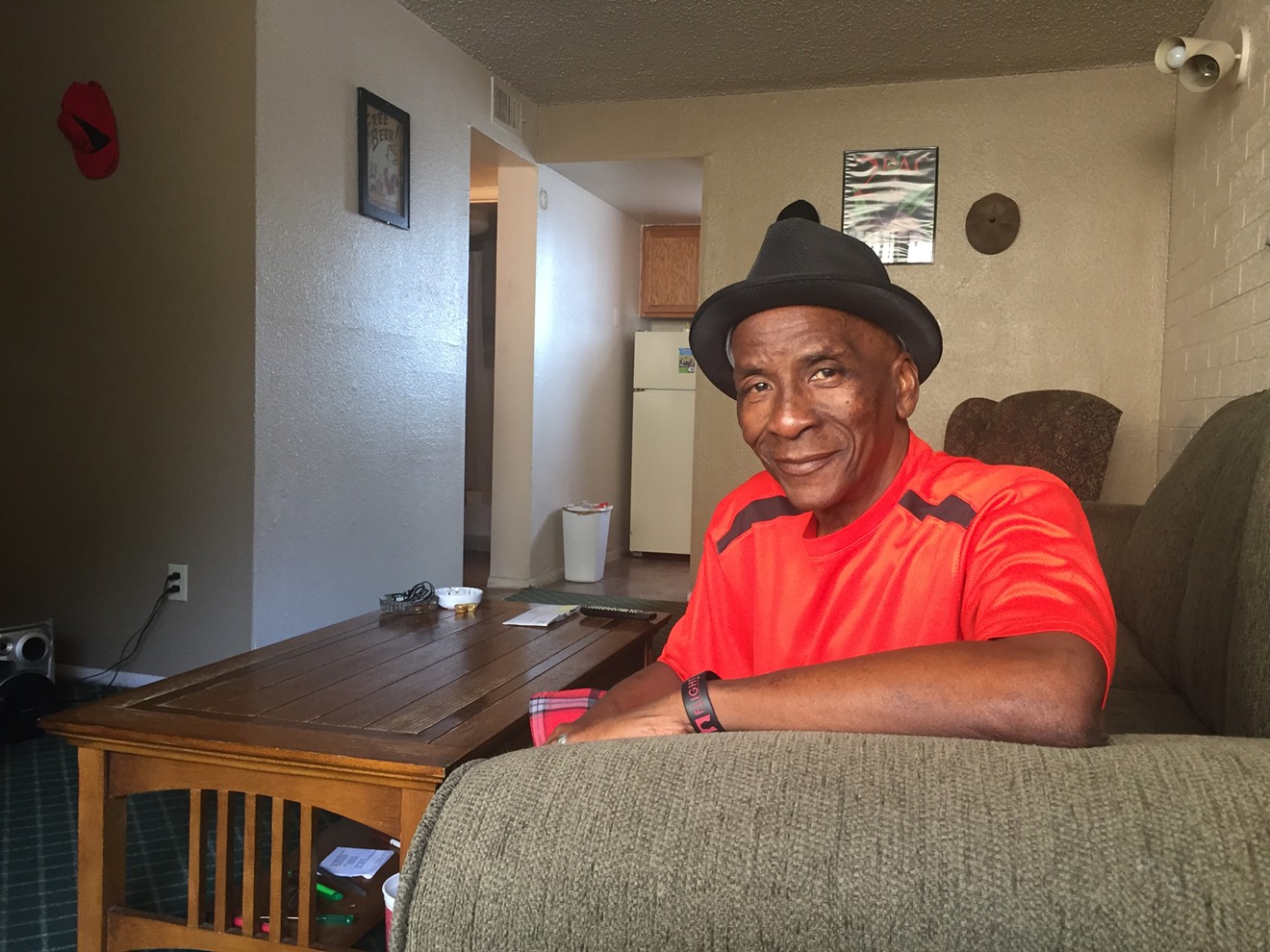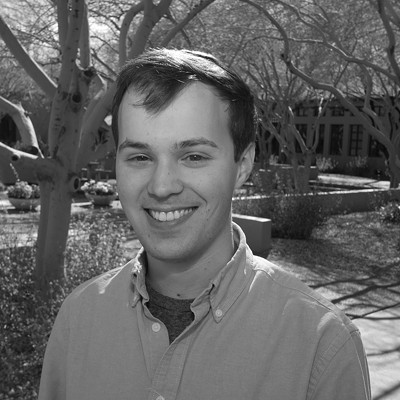But after he moved to Arizona in summer 2015, Spicer’s life took a wrong turn. His marriage had fallen apart, and in the course of a messy split, his wife terminated their lease in Phoenix and left, with their two kids, to live with her mother. Spicer found himself without a home, like something out of a bad dream.
“I had one jogging suit, a pair of shoes, a jacket, and a pair of headphones to my name,” he said.
The sudden run of bad luck came as a shock for the 42-year-old who had never been homeless and grew up outside of Chicago. “All this stuff is very new to me,” Spicer said. “I’ve always had a few cars, and lived in nice places in the Midwest. This has been the roughest two years of my life,” he added.

Ivan Spicer, 42, at home in his apartment. He received assistance from a rapid-rehousing program.
Courtesy of Ivan Spicer
Spicer jumped at the chance. In March 2016, he moved into an apartment, which he credits as a “phenomenal help” that allowed him pick up the pieces of his life.
“I’d recommend rapid rehousing for anybody going through what I went through,” he told Phoenix New Times.
The trial program relies on a radically simple solution to chronic homelessness: Provide homes.
More than 250 individuals experiencing homelessness in Phoenix were placed in apartments thanks to a United Way pilot program. Better yet, the vast majority have stayed in permanent housing now that the program is over.
The Phoenix program employed the rapid rehousing strategy to quickly move single adults from an overflow homeless shelter to apartments of their own between July 2015 and August 2016.
All the while, case managers assisted with their day-to-day challenges and needs. The program coordinators paid rent and other up-front costs for individuals while they navigated the job market or applied for disability benefits.
Rapid rehousing, in Phoenix’s case, seems to have worked: Approximately 73 percent of people who received assistance have stayed in permanent housing now that the program has ended.
Experts on homelessness tout rapid rehousing as a solution to help people get back on their feet. And while it might seem counterintuitive, this strategy is often less expensive than a patchwork approach of emergency shelters or transitional housing, according to the National Coalition to End Homelessness. The Phoenix program bore this out: Although the project’s funders budgeted $10,000 to house each person, actual costs were between $5,000-7,000.
Amy Schwabenlender, vice president of community impact for Valley of the Sun United Way, said the Phoenix-based organization is “excited and encouraged” by the results. She explained that Phoenix’s program was one of the first of its kind to serve single men and women through rapid rehousing – providing valuable data and paving the way for future programs.
“Everything we had to base it on was how that type of housing would serve families,” Schwabenlender told New Times.
And while the stories of how they ended up without a home varied, Schwabenlender said aid recipients were uniformly surprised and glad to have a place of their own – “the sort of disbelief that they can receive help with finding housing, and that it wasn’t a super short-term thing or something that’s going to be taken away from them,” she told New Times.
The new strategy follows on the heels of Maricopa County’s recent missteps when addressing chronic homelessness.
In recent years, scores of homeless residents of Phoenix would spend the night in all-around awful conditions: a parking lot near Madison Street that was infested with rats and lacked potable drinking water. The so-called East Lot was next door to the Maricopa County Men’s Overflow Shelter, and Schwabenlender said more than 300 people would often sleep in the East Lot when the overflow shelter was full.
After prolonged public outcry, the overflow shelter and parking lot finally closed in 2015 after the state fire marshal declared the shelter unfit for habitation. The rapid-rehousing efforts that are now in motion were born out of discussions that followed the overflow shelter's closure two years ago.
Director of the Maricopa County Human Services Department Bruce Liggett told New Times, “We really tried to develop alternatives to what was happening in the overflow shelter and parking lot. [Rapid rehousing] was one of our primary strategies.”
In contrast to bureaucratic inertia or fumbled attempts to combat homelessness in Phoenix, rapid rehousing looks extremely promising.
“We’re all so pleased with these results in terms of the percentage of people that were placed and who continue to stay placed,” Liggett said. “And rapid rehousing is a proven solution for homelessness.”
Witnessing the excitement of new renters as they moved into an apartment of their own was an extra benefit, he added.
“Those were really special days, those move-in days,” Liggett said.
With support from United Way, the Nina Mason Pulliam Charitable Trust, the Arizona Community Foundation, and the industrial development authorities of Phoenix and Maricopa County, $2.5 million was raised for the joint public-private program.
The Arizona Department of Housing also has renewed its commitment to fund rapid rehousing programs during the upcoming fiscal year, according to Schwabenlender.
Despite the success of this trial, chronic homelessness in Phoenix is a serious – and growing – public health issue. Maricopa County’s most recent count in January showed there were approximately 3,600 people experiencing homelessness in shelters and more than 2,000 people going unsheltered overnight. That's a 60 percent rise in the number of people sleeping on the street than just two years ago.
However, in theory many people going without shelter now could qualify for rapid rehousing down the road.
“We haven’t stopped, and we know we need to do more,” Schwabenlender said.
The location of some of the apartments seems to have been an area of concern. In one frightening encounter last fall, Spicer was shot at random by an intruder at his door: “It’s a blessing I’m alive,” he said.
According to a report by Focus Strategies, a consulting group that reviewed the Phoenix program, several participants said they were dissatisfied with their apartment's location; it felt dangerous, they told a focus group.
Spicer moved into a new apartment after the shooting, but likes his current place and has no plans to move again. Because of his injury, the rehousing program extended his rent assistance. After an upcoming surgery, Spicer will pursue a few job leads and "reassume life as I know it," exiting the program in August.
With any luck, the nightmare will be in the rearview mirror.












